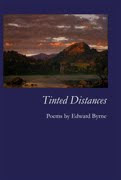 The centerpiece and longest poem, taking up an entire middle section of the three in David Bottoms’ Waltzing through the Endtime, focuses on an incident the poet remembers happening “one night in ’65.” In “Homage to Buck Cline,” a seven-page eleven-part piece of personal recollection from four decades ago, Bottoms elaborates upon a fairly ordinary occurrence in order to provide source material that allows him to muse upon elements “lit in an uncluttered niche” of memory. The work winds its lines of reminiscence and speculation around a teenage experience in which the speaker, “stoned on a glass of Mateus rosé,” is pulled over for running his father’s Impala through “the traffic light at the corner of the North Canton Store / where sour Buck Cline sat in the dark patrol car with the gold badge / of the Canton Police stenciled on his door.” Out of respect for the boy’s father, whom the officer recalls with reverence as a tough high school football star wounded in World War II, the teenager is let off without arrest or the need to answer to his father for his recklessness.
The centerpiece and longest poem, taking up an entire middle section of the three in David Bottoms’ Waltzing through the Endtime, focuses on an incident the poet remembers happening “one night in ’65.” In “Homage to Buck Cline,” a seven-page eleven-part piece of personal recollection from four decades ago, Bottoms elaborates upon a fairly ordinary occurrence in order to provide source material that allows him to muse upon elements “lit in an uncluttered niche” of memory. The work winds its lines of reminiscence and speculation around a teenage experience in which the speaker, “stoned on a glass of Mateus rosé,” is pulled over for running his father’s Impala through “the traffic light at the corner of the North Canton Store / where sour Buck Cline sat in the dark patrol car with the gold badge / of the Canton Police stenciled on his door.” Out of respect for the boy’s father, whom the officer recalls with reverence as a tough high school football star wounded in World War II, the teenager is let off without arrest or the need to answer to his father for his recklessness.However, this narrative of actual actions does not represent the most significant aspect of the poem. Instead, the various mental associations evoked by those events for the poet present a pattern of thoughtful rumination that may fascinate readers, especially when imagination and memory are blended: “And imagination, of course, depends on so much . . . // Take the polished memory of my grandfather’s horse barn / and its hayloft full of jewels.” In fact, Bottoms finds everyone holds “something divine in the memory,” perhaps even when we are reminded of painful moments in our history, as when the father’s war wound can be felt with each step he takes “across the concrete garage / on that splinter of a bone the Japanese navy left in his leg.” By the end of this poem, the poet declares: “memory toughens us up for that tumble / and drift of eternity, for the unpatrolled landscape / of the psyche unfurling.”
Indeed, throughout this collection, David Bottoms patrols those crossroads where memory and imagination intersect, as in “Kenny Roebuck’s Knuckle-Curve,” a boyhood recollection as extended metaphor where “once again the world isn’t what you think, / and the memory, already wobbling, knuckles off / into voices, laughter, jeers.” In “Black Hawk Rag” the speaker plays notes on an old mandolin as he tries to revive images and sounds of his grandfather hunched with a “fiddle under chin” in a garage beside his store; although, the speaker believes it may be “silly to lean on the rhythms of memory, / which will hardly give back even the threads of that rag.”
Nevertheless, the rhythms of memory continually fill this book to revive characters and contexts from the poet’s past, even to the point of reliving some circumstances similar to those in Bottoms’ first book, Shooting Rats at the Bibb County Dump, but this time with a more mature perspective. In “Shooting Rats in the Afterlife” Bottoms insists “the memory is so persistent, and territorial. Take Macon, Georgia, 1971, / which I carry around in my head, like a classic video.” (The word “memory” appears repeatedly in this poem, as it does so often throughout the rest of the collection.) Bottoms concludes: “through memory we create our own afterlives,” those narratives of the former times that define for us who we are or where we have been. As the speaker recalls the situation of driving to shoot rats in a dump with his drunken buddies, he reveals: “ We rode slow, / although everything moves slowly in memory. / Which is part of the act of savoring.”
One set of memories arises when the poet visits a former home of his favorite musicians (“In the Big House of the Allman Brothers My Heart Gets Tuned”) where twenty-eight years ago he stood outside and listened to the band rehearse. He also recounts an episode during which—“stupefied / and afraid, skulking on all fours through those briary terraces / of Rose Hill Cemetery”—he sat at the “slab of Elizabeth Reed,” the inspiration for one of the group’s finest songs. (In Vagrant Grace a similar poem, “At the Grave of Martha Ellis,” references Duane Allman’s song, “Little Martha.”) Ironically, two of the band members mentioned in the new poem, Duane Allman and Berry Oakley, were buried in the Rose Hill Cemetery upon their untimely deaths. But Bottoms also remembers those days when he could “hear through bricked Tudor wall / and blanketed windows an electric concussion of bass / and guitar,” when he even met Duane Allman “eye to bloodshot eye / in a Kmart.” Bottoms wonders whether remembering such activities constitutes “strung-out memory / or middle-aged panic.” As the poet indicates, such memories overcome the transitions time has dragged with it, and when brought to mind, for him it is “as though the house, / my heartbeat, the larger night, were all tuning up for the lifting / of some curtain.”
In an extended essay I had written about Bottoms’ previous volumes of poetry for the Spring/Summer 2000 issue of VPR, I suggested that Bottoms displayed greater complexity when his meditative lyrics developed slowly in lengthier poems. As in his last collection, Vagrant Grace, Bottoms appears mesmerized by the intricate nature of one’s memories, especially as they are introduced or interpreted through the imaginatively manipulated renderings of the poetic process. Therefore, the longer form for most of the works in this book (which contains only 14 poems in its 59 pages) complements the contemplative temperament of the pieces’ speakers.
Bottoms establishes early a relaxed, pensive, and reflective atmosphere in an excellent opening poem, “Easter Shoes Epistles,” which contains a sequence of observations or narratives threaded together by images of shoes and statements that explore variations on the issue of faith: “we have to travel on faith, struggling not to notice the absence, / the stray shoe in the street.” The speaker’s mother even refers to faith as “just like an old shoe.” However, memory remains central to the poet: “It’s odd what the memory smuggles into the afterlife— / the squeak of my mother’s shoes, / or a baseball game from the fifties, my father’s wing tips / kicking up a coaching box—pocket charms against oblivion.” The last section of the poem brings together its different items—shoes, faith, Easter, memory—in a traumatic second-grader’s situation, experienced by the speaker’s wife when she was young and poor, “with one dress / salvaged from a house fire,” and “ashamed of her shoes.” Taken by a Sunday-school teacher to the mall, the cathedral for consumers, she is suddenly confronted by “fountains of brass cherubs, / chandeliers, skylights, and that one fragile storefront of glass / where every wall sparkles with shoes.”
Additionally, Bottoms expertly combines the narratives’ gritty realistic details with some subtle philosophical introspection. The poet’s language comfortably accommodates natural colloquial conversation as well as lovely and lyrical description of nature. Apparently disparate sides of the poet come together nicely with “Melville in the Bass Boat,” where the speaker, unable to catch a fish despite hours “throwing deep runners, live shiners, rattle-bugs and jigs,” opens his “slightly soggy” paperback edition of Moby Dick. As the epigraph hints, “meditation and water are wedded forever.” Indeed, throughout these poems a number of literary figures are invoked and quoted by their speakers, including Homer, Blake, Whitman, Melville, Poe, Emerson, Coleridge, Jung, Rilke, Lawrence, O’Connor, and Warren.
Nevertheless, the most prominent quote is drawn from the poet’s mother-in-law, whose phrase, “Waltzing through the Endtime,” provides the book’s title. In the closing poem of the collection, “Three-quarter Moon and Moment of Grace,” Bottoms tells readers that’s what she calls his worrying and wondering about life, his habit of “wringing out my spirit like a dirty dishrag.” Near the end of this final work Bottoms once more turns toward the sense of recollection as a primary influence in our lives: “doesn’t it all come down to memory . . .?” However, just like the book’s first poem and others in between, this last poem also raises unanswered questions about faith and its mysteries: “and what are we dragging in that heavy sack / if not the cornerstones of Heaven, or the charcoals of Hell?”
As witnessed in his recent previous volumes, David Bottoms frequently seeks spiritual significance from among everyday experiences or observed ordinary events, and he offers life lessons learned from scattered fragments of remembered adventures. With his more mature voice, Bottoms also demonstrates a greater penchant for self-reflection in meditative language: “Days now I’ve pondered / what my mother-in law calls the Endtime” (“Vigilance”). Nevertheless, his poetry continues to be based in precise and persuasive descriptions, and the language remains narrative yet melodic. The poet’s balance of vivid imagery and expressive lyricism nicely combines nature with art in Waltzing through the Endtime, regularly giving readers a sense of pensive composition, much like that “mandolin trilling out the indecipherable harmony” in “O Mandolin, O Magnum Mysterium” with its music of “melancholy little sparrow-cries / fluttering over the riffled water.”
Bottoms, David. Waltzing through the Endtime. Copper Canyon Press, 2004.























No comments:
Post a Comment